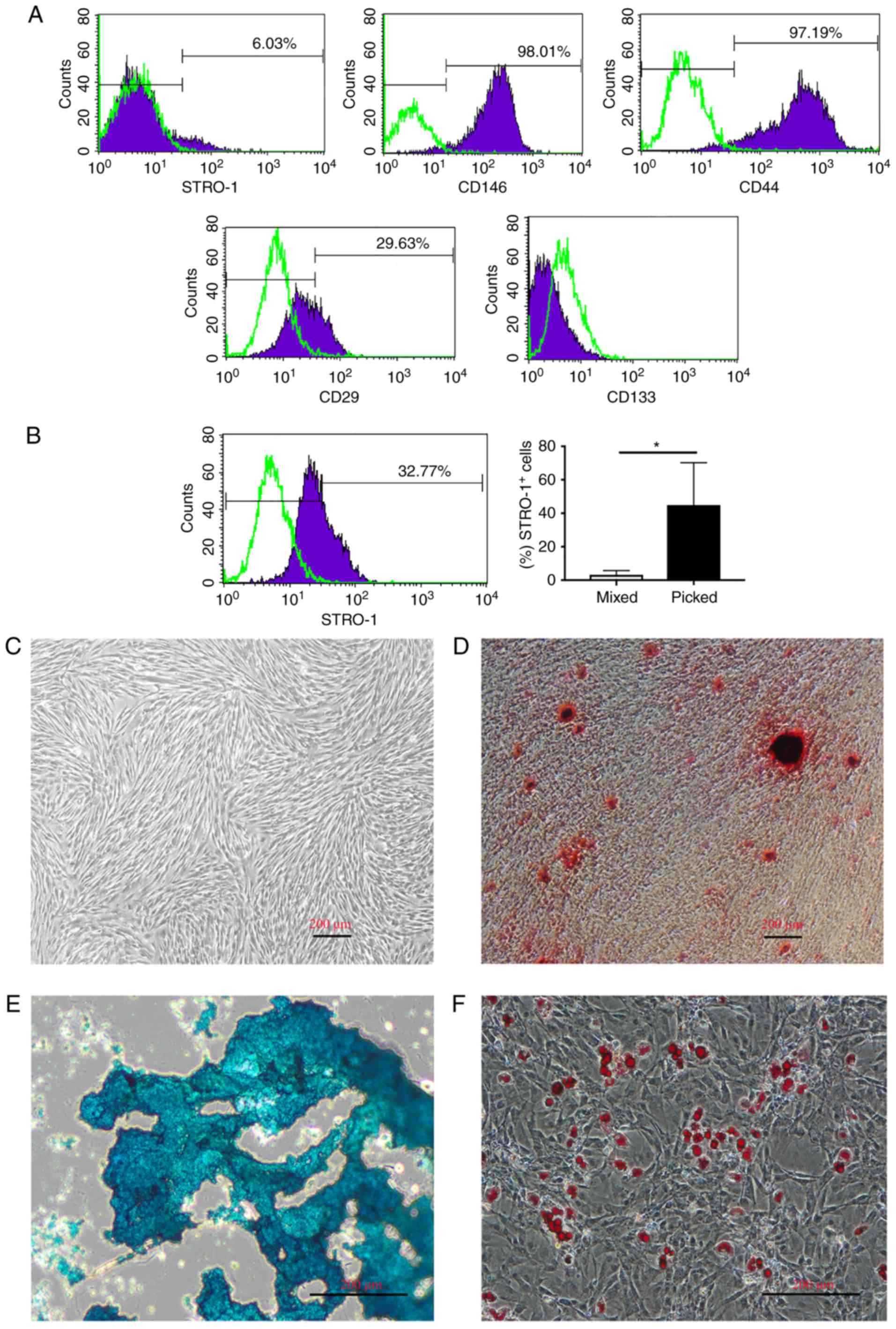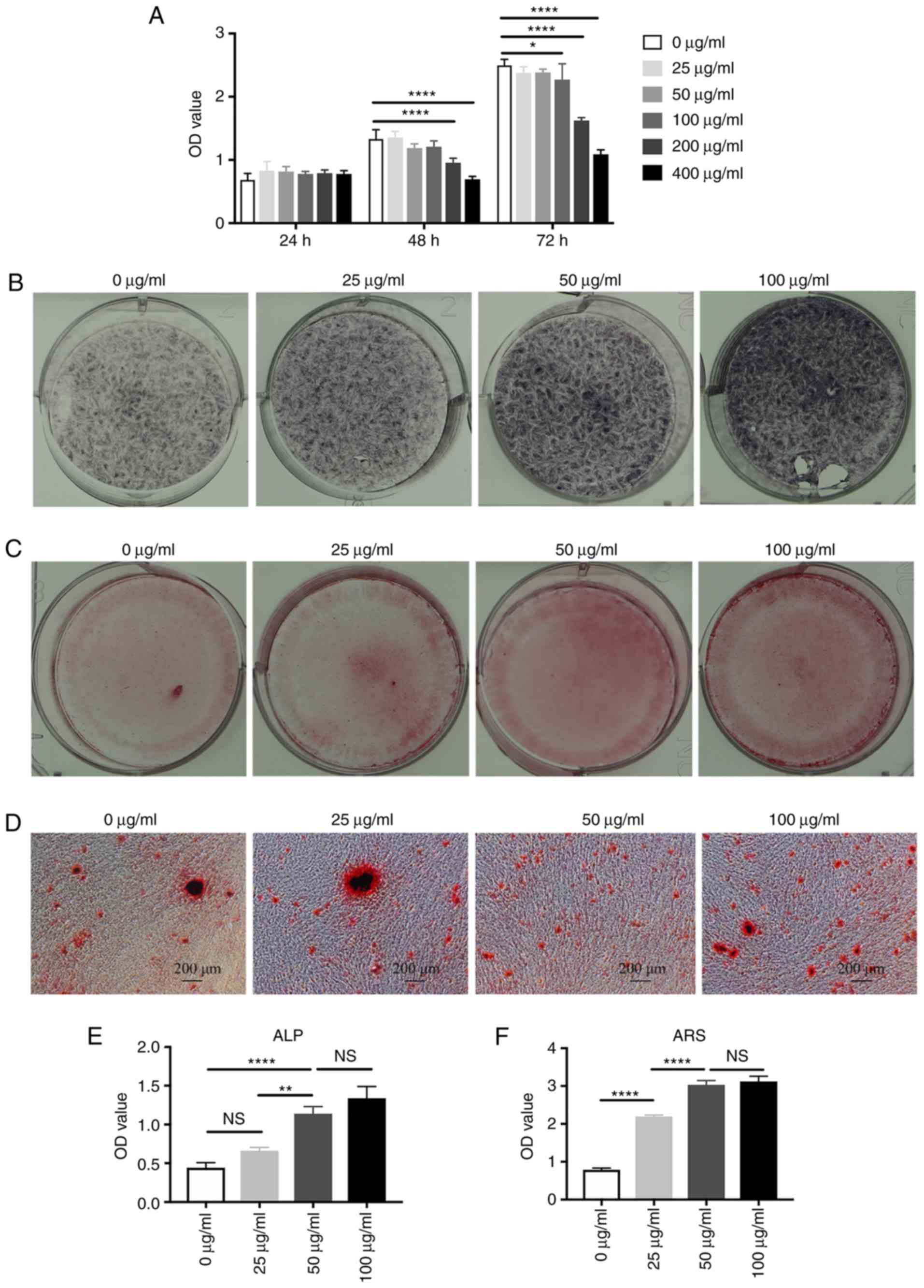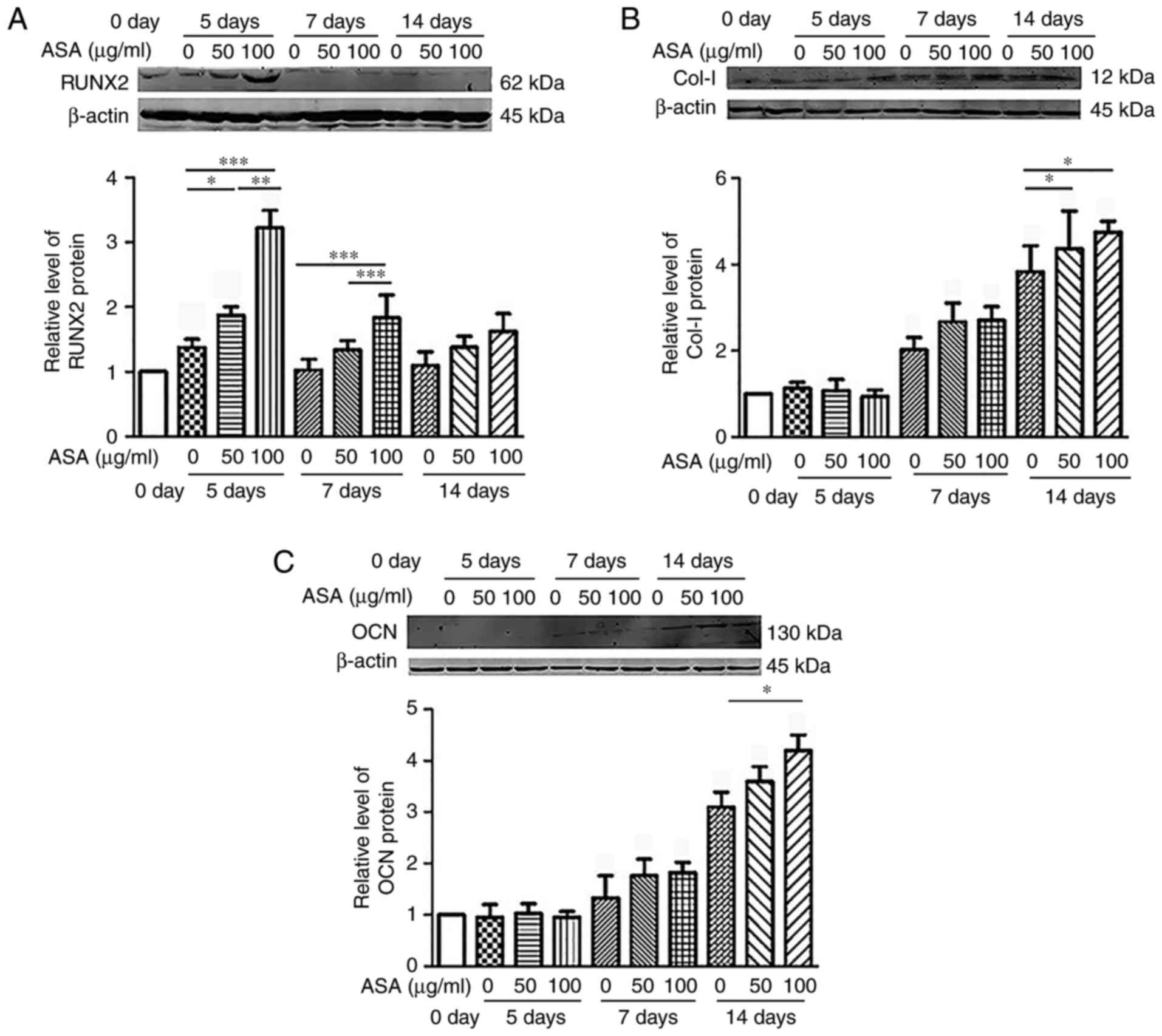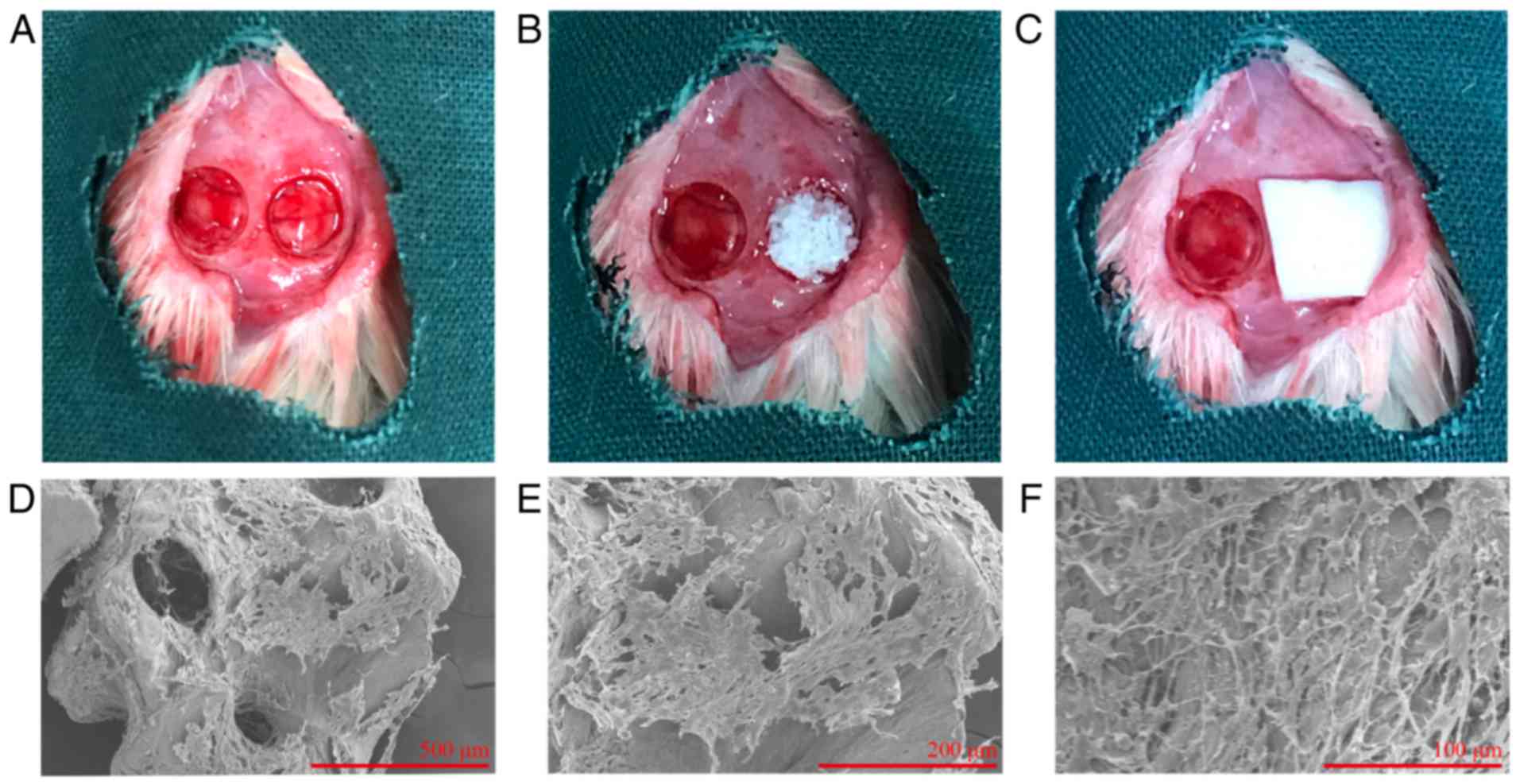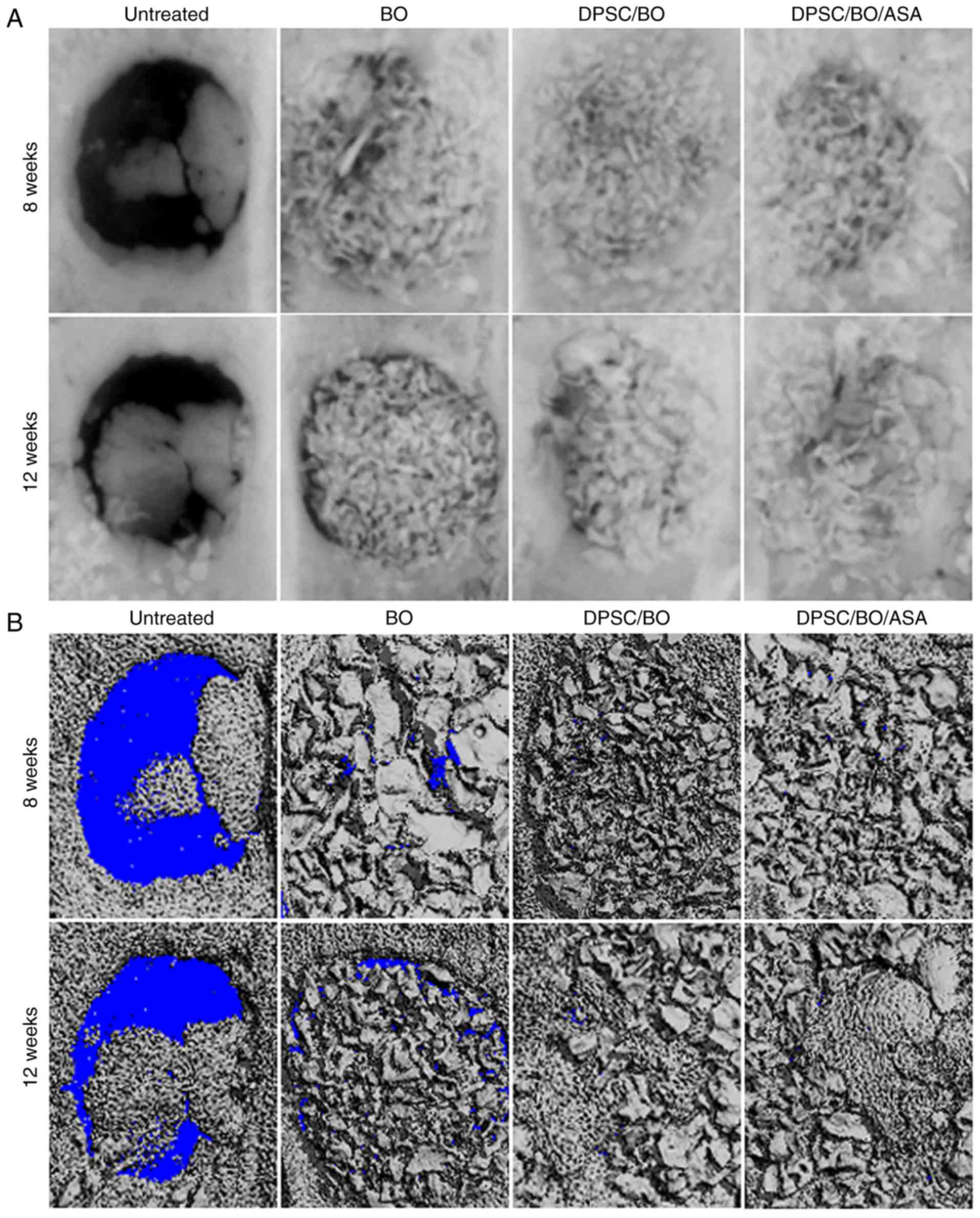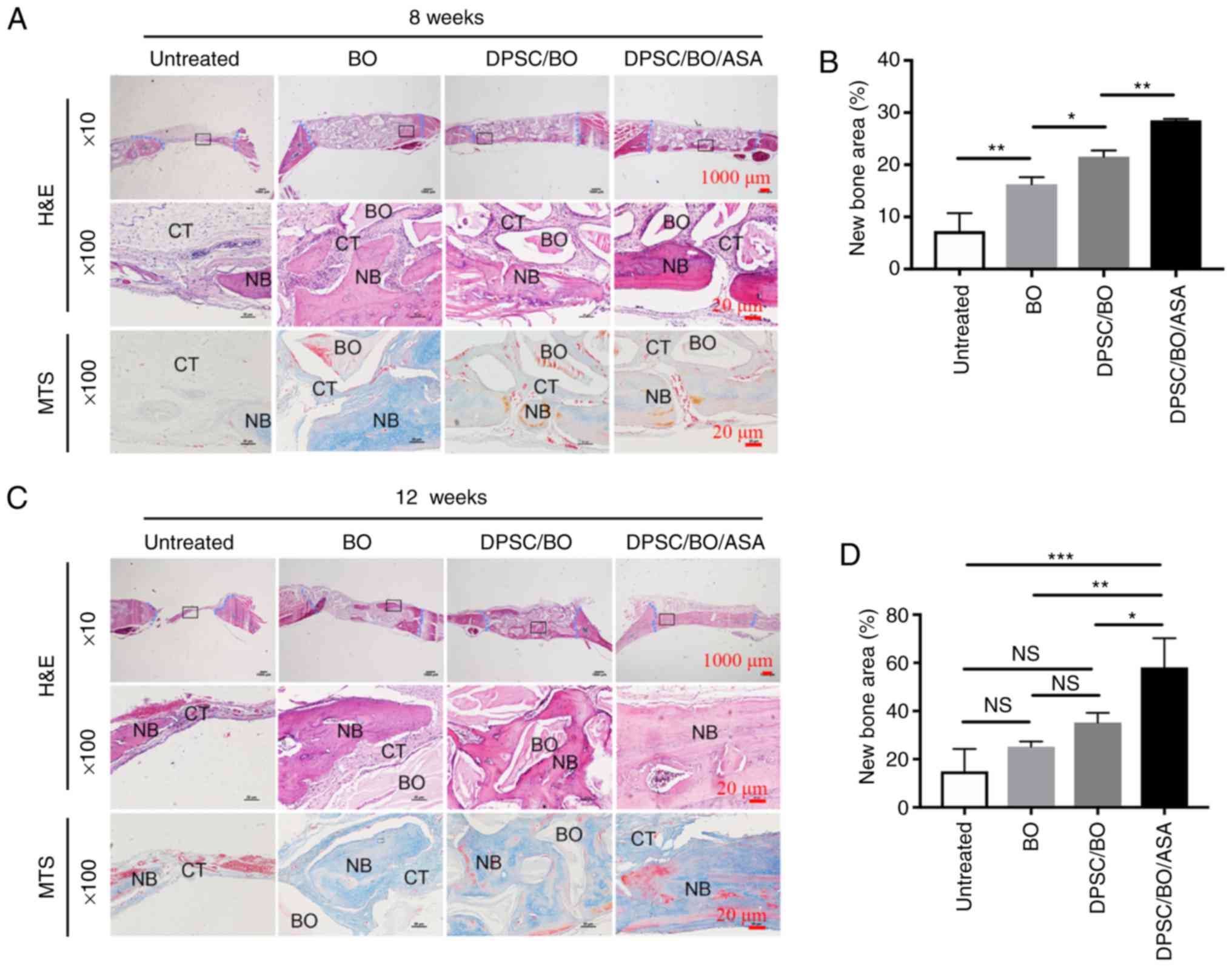Aspirin promotes osteogenic differentiation of human dental pulp stem cells
- Authors:
- Published online on: August 2, 2018 https://doi.org/10.3892/ijmm.2018.3801
- Pages: 1967-1976
-
Copyright: © Yuan et al. This is an open access article distributed under the terms of Creative Commons Attribution License.
Abstract
Introduction
Human dental pulp stem cells (hDPSCs) are self-renewing, highly proliferative, multi-potent stem cells that are derived from enzymatically disaggregated adult human dental pulp (1). More than 90% of dental pulp cells (DPCs) display positive expression of the endothelial cell markers CD29, CD44 and CD146, while >20% of DPCs express STRO-1, a mesenchymal stromal progenitor marker. Furthermore, DPCs have a negative expression of hematopoietic markers, including CD34, CD45 and CD133, and the endothelial marker, CD106 (2). Previous studies have demonstrated that hDPSCs exhibit a higher proliferative rate compared with human bone marrow stromal cells (hBMSCs), and are able to differentiate into odontoblasts/osteoblasts, chondrocytes, adipocytes and neural cells in vitro (1,3,4). However, unlike BMSCs, DPSCs exhibit an odontogenic capability to form specific crystalline structures in mineralized nodules, similar to physiological dentin but distinct from bone structures (5). A previous study revealed that DPSCs, similar to mesenchymal stem cells (MSCs), possess immunomodulatory properties, and that Fas ligand governs the immunoregulatory properties of DPSCs in the induction of T-cell apoptosis (6). Taken together, hDPSCs may represent good sources of stem cells for experimental and clinical studies.
Aspirin, also known as acetylsalicylic acid (ASA), is the most widely used antipyretic, analgesic and non-steroidal anti-inflammatory drug (7). It affects multiple biological pathways by inhibiting cyclooxygenase and decreasing the production of prostaglandins (7). Previous studies have suggested that aspirin has the potential to promote bone regeneration (8–11). Aspirin increased the osteogenic capacity of bone marrow MSCs (BMMSCs) by targeting the telomerase activity, and inhibited osteoclast activity in mice (8). In addition, aspirin promoted BMMSC-based bone regeneration via inhibiting tumor necrosis factor-α and interferon-γ production in skull defect models (9). Administration of aspirin was capable of improving BMSC-mediated calvarial bone regeneration in a porcine model (10), as well as osteogenic differentiation and immunomodulation mediated by stem cells derived from exfoliated deciduous teeth (11). Aspirin has also been demonstrated to enhance the function of periodontal ligament stem cells and may have regenerative dentistry applications (12). Combined use of aspirin and adipose-derived stem cells has been reported to partially reverse bone loss caused by castration in rats (13). In addition, regular administration of aspirin may have a moderate beneficial effect on bone mineral density in human patients (14). However, to the best of our knowledge, no previous studies have assessed the effect of aspirin on the osteogenic capacity of hDPSCs.
In the present study, the impact of aspirin on bone repair on hDPSC-seeded anorganic bovine bone (Bio-Oss), a tissue-engineered construct, was assessed in a rat calvarial defect model.
Materials and methods
Isolation and culture of hDPSCs
The present study was approved by the Ethical Board of the Second Affiliated Hospital of Harbin Medical University (Harbin, China). Written informed consent was obtained from the parents of the healthy donors (age, 14–18 years; 5 males and 2 females) undergoing orthodontic treatments. Briefly, cells were isolated from dental pulp tissue of extracted permanent teeth as previously described (1,3,4). The cells were cultured in Human Mesenchymal Stem Cell Growth Medium (Cyagen Biosciences, Inc., Guangzhou, China) supplemented with 10% fetal bovine serum (FBS), 10 mM glutamine and 100 U/ml penicillin-streptomycin at 37°C with 5% CO2 in humidified incubator. At 3–4 days later, non-adherent cells were removed, and the medium was changed every 2 days thereafter. After ~14 days, colony formation unit-fibroblasts were formed (1), and various methodologies were performed.
A mixed colony culture was performed similarly to a multi-colony derived cell culture, as reported previously (15). Briefly, primary cells were passaged when colonies began to merge on days 12–14 with 0.25% trypsin-EDTA (Gibco; Thermo Fisher Scientific, Inc., Waltham, MA, USA), following which all colonies and other cells were combined. For a picked colony culture, after 14–16 days, individual round colonies (>10 per flask) were selected and pooled together in a new flask. Upon reaching 80–90% confluency, cells were collected with 0.25% trypsin-EDTA and passaged. At passage 3 (P3), adherent cells were collected, characterized and used in further experiments.
Flow cytometric analysis for cell characterization
P3 cells at confluence in 25-cm2 flasks were collected and stained at 4°C for 30 min with antibodies against human CD29 (1:100; cat. no. 559882), CD44 (1:100; cat. no. 550989), CD133 (1:100; cat. no. 566593) and CD146 (1:100; cat. no. 550315; BD Biosciences, San Jose, CA, USA), as well as anti-STRO-1 antibody (1:50; cat. no. FAB1038G; R&D Systems, Minneapolis, MN, USA). Subsequently, cells were analyzed using a FACS Calibur flow cytometer and Cell Quest software (BD Biosciences).
Multilineage differentiation of hDPSCs
P3 cells were seeded at 15×104 cells/well in 6-well plates (Corning Incorporated, Corning, NY, USA) and cultured in Human Mesenchymal Stem Cell Growth Medium (Cyagen Biosciences, Inc., Guangzhou, China) supplemented with 10% FBS, 10 mM glutamine and 100 U/ml penicillin-streptomycin at 37°C with 5% CO2 in a humidified incubator. Cells were then treated with osteogenic, chondrogenic and adipogenic induction medium for 2–3 weeks as previously reported (16). Trilineage differentiation of hDPSCs was evaluated by alizarin red, alcian blue and Oil Red O stains using a Human Mesenchymal Stem Cell Differentiation kit (Thermo Fisher Scientific, Inc.), in accordance with the manufacturer's protocol.
Aspirin cytotoxicity assay
The effect of aspirin on hDPSC viability was assessed using Cell Counting Kit-8 (Beyotime Institute of Biotechnology, Nantong, China), in accordance with the protocol provided by the manufacturer. Briefly, hDPSCs were seeded at a density of 4,000 cells/well in a 96-well flat-bottom plate (Corning Incorporated) in triplicate. Cells were maintained in 100 μl standard medium containing 0, 25, 50, 100, 200 or 400 μg/ml aspirin (Sigma-Aldrich; Merck KGaA, Darmstadt, Germany) for 24, 48 or 72 h.
Alkaline phosphatase (ALP) staining and Alizarin red staining (ARS)
Cells were cultured in Human Mesenchymal Stem Cell Osteogenic Differentiation Medium (Cyagen Biosciences, Inc.) containing 10% FBS, 100 U/ml penicillin-streptomycin, 0.2 mM ascorbate, 10 mM β-glycerophosphate and 10−7 M dexamethasone. After 24 h, aspirin (0, 25, 50 and 100 μg/ml) was added to hDPSCs that were seeded at 15×104 cells/well in 6-well plates (Corning Incorporated).
ALP staining was conducted at day 14 using a BCIP/NBT staining kit (Beyotime Institute of Biotechnology, Shanghai, China), according to the manufacturer's protocol. NBT formazan was collected using 100 mM cetylpyridinium chloride monohydrate (CPC; cat. no. C9002-25G; Sigma-Aldrich, Merck KGaA), and absorbance was read at 560 nm with a microplate reader (iMARK Microplate Absorbance Reader; Bio-Rad Laboratories, Inc., Hercules, CA, USA).
For the ARS assay, hDPSCs were cultured for 21 days and then fixed with 75% ethanol, followed by staining with 2% alizarin red (Beijing Solarbio Bioscience & Technology Co., Ltd., Beijing, China; pH 4.2). Unbound and nonspe-cifically bound stain was removed by rinsing with distilled water. Calcium-bound stain was collected with 100 mM CPC, and absorbance was read at 560 nm with a microplate reader (iMARK Microplate Absorbance Reader; Bio-Rad Laboratories, Inc.).
Reverse transcription-quantitative polymerase chain reaction (RT-qPCR)
Cells were homogenized for RNA extraction using the RNeasy mini kit (Qiagen, Hilden, Germany). The RNA concentrations were measured by a Nanovue spectrophotometer (GE Healthcare Life Sciences, Marlborough, MA, USA), and the total RNA was then reverse-transcribed to cDNA using the Prime Script First Strand cDNA Synthesis kit (Takara Bio, Inc., Kusatsu, Japan) on the MxPro-Mx3000P Real-Time PCR System (Stratagene; Agilent Technologies, Inc., Santa Clara, CA, USA). PCR was then performed to determine the expression levels of target genes, and gene expression was normalized to that of β-actin. The relative differences in the PCR results were calculated by using the 2−ΔΔCq method (17). The thermo-cycling conditions were as follows: 95°C for 2 min, followed by 40 cycles of 95°C for 15 sec and 60°C for 30 sec. The primers used in this analysis are listed in Table I (Invitrogen; Thermo Fisher Scientific, Inc.).
Western blotting
The cells were harvested and proteins were extracted with RIPA lysis buffer (Beyotime, Shanghai, China). The protein concentration was determined using the BCA protein Assay (Beyotime, Shanghai, China). Equal aliquots of 40 μg per sample were separated by sodium dodecyl sulfate-polyacrylamide gel electrophoresis (10–12%) and transferred to polyvinylidene difluoride (PVDF) membranes (Millipore, Bedford, MA, USA). Following blocking in 5% nonfat dry milk (dissolved in TBST, TBS plus 0.1% Tween-20) for 1 h at room temperature, the proteins of interest were probed with primary antibodies overnight at 4°C: osteocalcin (1:1,000; cat. no. ab13418; Abcam, Cambridge, UK), collagen I (1:1,000; cat. no. ab6308; Abcam), runt-related transcription factor 2 (RUNX2;1:1,000; cat. no. 12556; Cell Signaling Technology, Inc., Danvers, MA, USA) and β-actin (1:5,000; cat. no. 3700; Cell Signaling Technology, Inc.). Subsequently, membranes were incubated with IRDye 800CW-labeled goat anti-rabbit IgG (H+L; 1:10,000; cat. no. 926-32211; LI-COR Biosciences, Lincoln, NE, USA) and goat anti-mouse IgG (1:10,000; H+L; cat. no. 926-32210; LI-COR Biosciences) for 1 h at room temperature. The blots were then visualized using an Infrared Imaging System (LI-COR Biosciences, Lincoln, NE, USA). The band density was quantified using Odyssey software version 3.0 (LI-COR Biosciences) and normalized to β-actin.
Generation of rat calvarial bone defects and transplantation
The animal studies were approved by the Ethical Board of the Second Affiliated Hospital of Harbin Medical University. The 40 adult male Sprague-Dawley rats aged 9–10 weeks (200–250 g) used in this study were supplied by the Animal Center of the Second Affiliated Hospital of Harbin Medical University (Harbin, China; No. SYXK, 2013-002). The rats were housed in an animal facility with 20–23°C, 40–60% humidity and a 12-h light/dark cycle. Standard laboratory chow and water ad libitum were supplied. hDPSCs were cultured in Human Mesenchymal Stem Cell Osteogenic Differentiation Medium prior to implantation into the cranial defects. Briefly, Sprague-Dawley rats were anesthetized with intraperitoneal injection of 300 mg/kg chloral hydrate (10%; cat. no. C8383; Sigma-Aldrich; Merck KGaA), and then bicortical defects of 5-mm diameter were created with a stainless-steel trephine (18). The rats were randomly assigned to four different groups (n=10 per group) with the following: i) Untreated group, unfilled defects; ii) BO group, 0.02 g Bio-Oss (Geistlich Pharma AG, Wolhusen, Switzerland) only; iii) DPSC/BO group, hDPSCs (8×106 cells) + Bio-Oss; and iv) DPSC/BO/ASA group, hDPSCs (8×106 cells) treated with 100 μg/ml aspirin for 3 days using Bio-Oss as a carrier. Following the placement of the materials, the surgical site was covered with a native collagen membrane (Biogide®; Geistlich Pharma AG), and the soft tissues were closed with sutures. All the animals received a single dose of ampicillin (100 mg/kg; A6920, Beijing Solarbio Bioscience & Technology Co., Ltd.) 12 h post-surgery. The rats were sacrificed with an overdose of pentobarbital sodium (100 mg/kg; intravenous) at 8 or 12 weeks postoperatively, and the calvaria were immediately excised and fixed in 4% neutral-buffered formaldehyde.
Electron microscopy
To observe cells adhesion on scaffolds in vitro, hDPSCs were seeded on Bio-Oss at a density of 8×106 cells per 0.02 g Bio-Oss and cultured for 24 h. The samples were fixed in 2.5% glutaraldehyde and evaluated by scanning electron microscopy (SEM; S-3400; Hitachi, Ltd., Tokyo, Japan).
Radiography and micro-computed tomography (CT) scanning
Explanted calvaria samples were radiographed by X-ray (Faxitron Bioptics LLC, Tucson, AZ, USA) and scanned by a micro-CT scanner (μCT35; Scanco Medical AG, Bassersdorf, Switzerland) to examine the new bone within the defect region.
Histology
The specimens were fixed, decalcified and paraffin-embedded. Sections (4-μm) were prepared and then stained with hematoxylin and eosin (H&E) or with Masson's trichrome (MTS). New bone formation within the defect was measured histomorphometrically using an image analysis software (Image Pro Plus, version 7.0; Media Cybernetics, Inc., Bethesda, MD, USA).
Statistical analysis
The results are reported as the mean ± standard deviation of three independent experiments. The data were analyzed using GraphPad Prism software, version 6.0 (GraphPad Software, Inc., La Jolla, CA, USA). Multiple comparisons were performed by one-way analysis of variance followed by Tukey's test. P<0.05 was considered to indicate a statistically significant difference.
Results
hDPSCs express MSC markers and have multilineage differentiation potential in vitro
hDPSCs were characterized at P3 by flow cytometry, and the majority of cells were found to express STRO-1, CD146, CD44 and CD29. By contrast, CD133 expression was not evident (Fig. 1A). Furthermore, hDPSCs were cultured by picking established colonies at passage 0, which increased the percentage of STRO-1+ cells at P3 compared with the mixed colony culture method (44.9 vs. 3.25%; P<0.05). STRO-1 was expressed by ≤70% of cells (mean value, 44.9%; Fig. 1B). The cells proliferated rapidly following the subculture and homogeneously exhibited a fibroblast-like spindle shape (Fig. 1C). Cells were positive for ARS, alcian blue staining and Oil red O staining in response to osteogenic, chondrogenic and adipogenic induction, respectively (Fig. 1D–F). Taken together, these results indicated that hDPSCs possess MSC properties, and that the picked colony culture method is suitable for multipotent hDPSC culture and augments the STRO-1+ subpopulation.
Aspirin enhances osteogenic differentiation of hDPSCs in vitro
The present study first assessed the toxicity of aspirin on hDPSCs in vitro. Aspirin at concentrations of ≤100 μg/ml had no significant effect on the viability of hDPSCs within 72 h, while 200 and 400 μg/ml aspirin caused a significant decrease in cell viability at 48 and 72 h (Fig. 2A). Therefore, ≤100 μg/ml aspirin was used to treat hDPSCs in the following experiments. Next, it was demonstrated that aspirin increased ALP activity, whose expression by functional osteoblasts precedes mineralization (19), in a dose-dependent manner (Fig. 2B and E). The hDPSC-osteoinductive function of aspirin was then assessed by ARS, and the results revealed that 21-day aspirin treatment at doses of 50 and 100 μg/ml significantly augmented mineralized nodule formation by ~2–3 fold (Fig. 2C, D and F).
The study further examined the effects of aspirin on the expression levels of osteogenesis-associated markers, including RUNX2, collagen I and osteocalcin, in hDPSCs (Fig. 3). The results demonstrated that high doses of ASA (100 μg/ml) significantly improved the osteogenic differentiation of hDPSCs compared with the untreated groups in vitro. RUNX2 upregulation was observed on days 5 and 7 (Fig. 3A and D), while collagen I (Fig. 3B and E) and osteocalcin (Fig. 3C and F) were significantly upregu-lated on day 14, at the protein and mRNA levels (Fig. 3). Cumulatively, these data suggested that aspirin enhanced the osteogenic differentiation potential of hDPSCs in the ex vivo culture.
Aspirin improves hDPSC-based bone formation in vivo
Using a rat calvarial defect model (Fig. 4A–C), it was confirmed that aspirin enhanced the bone-forming capacity of hDPSCs in vivo. hDPSCs were seeded on Bio-Oss and incubated for 24 h prior to SEM examination. It was observed that hDPSCs dispersed as a monolayer and covered parts of the Bio-Oss surface (Fig. 4D–F). In addition, radiographs revealed incomplete healing after 8 or 12 weeks in untreated rats (Fig. 5A and B). By contrast, Bio-Oss significantly increased bone healing in the cranial defect model, and hDPSCs seeded on Bio-Oss further augmented the high-density area.
To assess whether aspirin improved new bone formation, the calvarial bone specimens were histologically analyzed, and aspirin was found to enhance the hDPSC-mediated bone formation in vivo (Fig. 6A–D). H&E and MTS staining revealed minimal new bone formation around the margins of the native bone in the untreated groups, where soft fibrous tissue filled the center of the defect area. Limited new bone formation was evident in the BO group, while a moderate amount of bone formation was noted in defects treated with DPSC/BO. Aspirin treatment resulted in abundant mineralized tissue formation at 8 and 12 weeks post-surgery (Fig. 6A and C). According to the H&E staining, more new bone was evident at the bottom of the defect during the earlier period of bone formation, and the untreated group exhibited significantly less new bone density in comparison with the other three groups at 8 weeks. Aspirin-treated hDPSCs exhibited significantly increased new bone formation, with woven/lamellar features in the defect area, as compared with the other groups at 12 weeks (Fig. 6B and D), indicating a pro-osteogenic effect exerted by aspirin (P<0.05). These findings suggested that aspirin improved bone formation when hDPSCs were seeded Bio-Oss in a rat cranial defect model.
Discussion
hDPSCs are easily isolated from the teeth of healthy donors undergoing orthodontic treatments. In addition, hDPSCs proliferate faster than hBMSCs and can differentiate into multiple cell types, particularly osteogenic cells (20). Previous studies have demonstrated that hDPSCs possess the ability to differentiate into neural, odontogenic and osteogenic cells, with the latter two cell types being able to form mineral-ized nodules in vitro (21,22). It has also been demonstrated that multi-colony-derived DPSCs have a potential capacity to proliferate in vitro and to regenerate dentin in vivo, as compared with single-colony-derived strains (3). In the present study, hDPSCs were cultured using mixed colony culture and picked colony culture methods at passage 0, the two of which initiated successful cell expansion.
DPSCs have been reported to express CD10, CD29, CD44, CD59, CD73, CD90, CD105, CD150 and CD166, but not hematopoietic cell surface markers, such as CD45, CD14, CD18, CD24, CD34 or CD133 (6,23). A previous study revealed that STRO-1 and CD146 (also known as melanoma cell adhesion molecule or MUC18) function as markers for pre-osteogenic stem cells and high-purity BMMSCs, respectively (24,25). The STRO-1+ fraction represented ~6% of the total pulp cells, which have higher capacity for colony formation and osteoblast differentiation (24,26). In the present study, it was demonstrated that STRO-1 was expressed by ≤70% of hDPSCs (mean value, 44.9%). This finding is consistent with previous studies reporting that STRO-1 is a marker of pre-osteogenic populations, the expression of which is lost upon cell proliferation and differentiation into mature osteoblasts.
Although DPSCs have similar characteristics to BMMSCs, DPSCs exhibit reduced osteogenic and adipogenic potentials compared with BMMSCs (1,6). The current study focused on investigating various potent regulators, such as cytokines or drugs, to regulate the differentiation of DPSCs. It has been reported that aspirin has an anti-proliferative effect on BMMSCs at high concentrations, but not at low ones (50–200 μg/ml) (27). This is consistent with the results of the present study, which revealed that aspirin exerted little effect on the number of hDPSCs at low concentrations (<100 μg/ml). That is likely due to different resources and protocols used for MSC culture that may result in different responses to aspirin.
DPSCs and BMSCs exhibited a similar expression pattern of bone markers, including ALP, collagen I, osteocalcin and osteopontin (1). RUNX2 is the early osteoblastic transcription factor (28). Collagen I, the dominant fibrous protein in hard tissues, such as bone and dentin, is secreted by mature osteoblasts. Osteoblasts produce a collagen extracellular matrix that becomes mineralized through various signaling molecules, particularly bone sialoprotein, osteopontin and osteocalcin (29). Osteocalcin is considered to be the latest-functioning expression marker in mature osteoblasts (28). It has been demonstrated that aspirin can affect the expression levels of those markers. For instance, Liu et al (11) reported that low doses of aspirin (10 and 50 μg/ml) treatment, but not a high dose (200 μg/ml), upregulated RUNX2 and ALP expression levels. This was consistent with the results of the present study, which demonstrated that the expression levels of RUNX2, collagen I and osteocalcin were elevated when the cells were treated with aspirin. This suggests that aspirin enhanced the osteogenic capacity of hDPSCs in vitro.
Bone engineering in craniomaxillofacial surgery requires scaffold/supporting materials, adequate target cells and osteo-genesis-inducing factors (30). Several in vivo experiments have indicated that DPSCs have potential applications in bone engineering (31), while aspirin promotes the bone-forming ability of BMSCs (9) and stem cells from human exfoliated deciduous teeth (11). The present study used Bio-Oss as a carrier to transplant hDPSCs into rat cranial defects with or without aspirin treatment. It was identified that aspirin treatment promoted hDPSC-induced bone regeneration. Bio-Oss is a commercially available bone substitute with osteoconductive properties that supports new bone formation for implant dentistry and maxillofacial surgery (32,33). However, a consensus regarding the biodegradation of Bio-Oss is yet to be reached. A number of investigators have observed that the bovine bone mineral is replaced by the newly formed bone (34,35), while others have indicated that the resorption process of Bio-Oss was markedly slow (36,37). Histological and histomorphometrical analyses in the current study indicated that the majority of the Bio-Oss particles were surrounded by new bone formation, indicating that Bio-Oss was biocompatible and osteoconductive. In addition, according to the H&E staining results, new bone was located adjacent to the dura mater during the early period of bone formation. Similarly, it has previously been reported that new bone formation localized to the area of the scaffold adjacent to the dura mater potentially indicates strong paracrine signaling between the underlying dura mater and the cells within the defect (38).
In conclusion, the present study demonstrated that hDPSCs exhibit stem cell properties, including expression of MSC markers and a capacity to differentiate into multiple cell lineages in vitro. This suggests that hDPSCs may be a feasible source of MSCs. Furthermore, aspirin improved the potential of osteogenic differentiation of hDPSCs in vitro and in vivo. Thus, the present study provides a promising basis for an hDPSC-based bone regeneration therapy.
Acknowledgments
The authors would like to thank Dr Quan Liu (Harbin Medical University, Harbin, China for the critical revision of this article.
Funding
This study was supported by the National Natural Science Foundation of China (grant no. 81570951 and 81500816), the Special Foundation for Sino-Russian Translational Medicine Research Center of Harbin Medical University (grant no. CR201412 and CR201504), the Natural Science Foundation of Heilongjiang Province of China (grant no. H2015103), the Research Innovation Fund of Harbin Medical University (grant no. 2016LCZX19), the Science Foundation of the Second Affiliated Hospital of Harbin Medical University (grant no. CX2016-20), and the Research Grant of Health and Family Planning Commission of Heilongjiang Province (grant no. 2016-060).
Availability of data and materials
All data generated or analyzed during this study are included in the published article.
Authors' contributions
BZ and YL conceived and designed the experiments. MY, YZ, NM and XX performed the experiments. MY, WH and HJ analyzed the data. MY wrote the paper.
Ethics approval and consent to participate
The experimental protocols of the present study were approved by the Ethical Board of the Second Affiliated Hospital of Harbin Medical University (Harbin, China).
Patient consent for publication
Not applicable.
Competing interests
The authors declare that they have no conflicts of interest.
References
|
Gronthos S, Mankani M, Brahim J, Robey PG and Shi S: Postnatal human dental pulp stem cells (DPSCs) in vitro and in vivo. Proc Natl Acad Sci USA. 97:13625–13630. 2000. View Article : Google Scholar : PubMed/NCBI | |
|
Wei X, Ling J, Wu L, Liu L and Xiao Y: Expression of mineralization markers in dental pulp cells. J Endod. 33:703–708. 2007. View Article : Google Scholar : PubMed/NCBI | |
|
Gronthos S, Brahim J, Li W, Fisher LW, Cherman N, Boyde A, DenBesten P, Robey PG and Shi S: Stem cell properties of human dental pulp stem cells. J Dent Res. 81:531–535. 2002. View Article : Google Scholar : PubMed/NCBI | |
|
Liu H, Gronthos S and Shi S: Dental pulp stem cells. Methods Enzymol. 419:99–113. 2006. View Article : Google Scholar : PubMed/NCBI | |
|
About I, Bottero MJ, de Denato P, Camps J, Franquin JC and Mitsiadis TA: Human dentin production in vitro. Exp Cell Res. 258:33–41. 2000. View Article : Google Scholar : PubMed/NCBI | |
|
Zhao Y, Wang L, Jin Y and Shi S: Fas ligand regulates the immu-nomodulatory properties of dental pulp stem cells. J Dent Res. 91:948–954. 2012. View Article : Google Scholar : PubMed/NCBI | |
|
Smith JB and Willis AL: Aspirin selectively inhibits pros-taglandin production in human platelets. Nat New Biol. 231:235–237. 1971. View Article : Google Scholar : PubMed/NCBI | |
|
Yamaza T, Miura Y, Bi Y, Liu Y, Akiyama K, Sonoyama W, Patel V, Gutkind S, Young M, Gronthos S, et al: Pharmacologic stem cell based intervention as a new approach to osteoporosis treatment in rodents. PLoS One. 3:e26152008. View Article : Google Scholar : PubMed/NCBI | |
|
Liu Y, Wang L, Kikuiri T, Akiyama K, Chen C, Xu X, Yang R, Chen W, Wang S and Shi S: Mesenchymal stem cell-based tissue regeneration is governed by recipient T lymphocytes via IFN-γ and TNF-α. Nat Med. 17. pp. 1594–1601. 2011, View Article : Google Scholar | |
|
Cao Y, Xiong J, Mei S, Wang F, Zhao Z, Wang S and Liu Y: Aspirin promotes bone marrow mesenchymal stem cell-based calvarial bone regeneration in mini swine. Stem Cell Res Ther. 6:2102015. View Article : Google Scholar : PubMed/NCBI | |
|
Liu Y, Chen C, Liu S, Liu D, Xu X, Chen X and Shi S: Acetylsalicylic acid treatment improves differentiation and immunomodulation of SHED. J Dent Res. 94:209–218. 2015. View Article : Google Scholar : | |
|
Abd Rahman F, Mohd Ali J, Abdullah M, Abu Kasim NH and Musa S: Aspirin enhances osteogenic potential of periodontal ligament stem cells (PDLSCs) and modulates the expression profile of growth factor-associated genes in PDLSCs. J Periodontol. 87:837–847. 2016. View Article : Google Scholar : PubMed/NCBI | |
|
Liu H, Li W, Liu Y, Zhang X and Zhou Y: Co-administration of aspirin and allogeneic adipose-derived stromal cells attenuates bone loss in ovariectomized rats through the anti-inflammatory and chemotactic abilities of aspirin. Stem Cell Res Ther. 6:2002015. View Article : Google Scholar : PubMed/NCBI | |
|
Bauer DC, Orwoll ES, Fox KM, Vogt TM, Lane NE, Hochberg MC, Stone K and Nevitt MC: Aspirin and NSAID use in older women: Effect on bone mineral density and fracture risk. J Bone Miner Res. 11:29–35. 1996. View Article : Google Scholar : PubMed/NCBI | |
|
Kuznetsov SA, Krebsbach PH, Satomura K, Kerr J, Riminucci M, Benayahu D and Robey PG: Single-colony derived strains of human marrow stromal fibroblasts form bone after transplantation in vivo. J Bone Miner Res. 12:1335–1347. 1997. View Article : Google Scholar : PubMed/NCBI | |
|
Lei M, Li K, Li B, Gao LN, Chen FM and Jin Y: Mesenchymal stem cell characteristics of dental pulp and periodontal ligament stem cells after in vivo transplantation. Biomaterials. 35:6332–6343. 2014. View Article : Google Scholar : PubMed/NCBI | |
|
Livak KJ and Schmittgen TD: Analysis of relative gene expression data using real-time quantitative PCR and the 2−ΔΔC T method. Methods. 25:402–408. 2001. View Article : Google Scholar | |
|
Spicer PP, Kretlow JD, Young S, Jansen JA, Kasper FK and Mikos AG: Evaluation of bone regeneration using the rat critical size calvarial defect. Nat Protoc. 7:1918–1929. 2012. View Article : Google Scholar : PubMed/NCBI | |
|
Shi S, Gronthos S, Chen S, Reddi A, Counter CM, Robey PG and Wang CY: Bone formation by human postnatal bone marrow stromal stem cells is enhanced by telomerase expression. Nat Biotechnol. 20:587–591. 2002. View Article : Google Scholar : PubMed/NCBI | |
|
Nuti N, Corallo C, Chan BM, Ferrari M and Gerami-Naini B: Multipotent differentiation of human dental pulp stem cells: A literature review. Stem Cell Rev. 12:511–523. 2016. View Article : Google Scholar : PubMed/NCBI | |
|
Liu M, Sun Y, Liu Y, Yuan M, Zhang Z and Hu W: Modulation of the differentiation of dental pulp stem cells by different concentrations of β-glycerophosphate. Molecules. 17:1219–1232. 2012. View Article : Google Scholar : PubMed/NCBI | |
|
Wang Y, Yao J, Yuan M, Zhang Z and Hu W: Osteoblasts can induce dental pulp stem cells to undergo osteogenic differentiation. Cytotechnology. 65:223–231. 2013. View Article : Google Scholar : | |
|
Ferro F, Spelat R, Beltrami AP, Cesselli D and Curcio F: Isolation and characterization of human dental pulp derived stem cells by using media containing low human serum percentage as clinical grade substitutes for bovine serum. PLoS One. 7:e489452012. View Article : Google Scholar : PubMed/NCBI | |
|
Shi S and Gronthos S: Perivascular niche of postnatal mesen-chymal stem cells in human bone marrow and dental pulp. J Bone Miner Res. 18:696–704. 2003. View Article : Google Scholar : PubMed/NCBI | |
|
Gronthos S and Zannettino AC: A method to isolate and purify human bone marrow stromal stem cells. Methods Mol Biol. 449:45–57. 2008.PubMed/NCBI | |
|
Yu J, He H, Tang C, Zhang G, Li Y, Wang R, Shi J and Jin Y: Differentiation potential of STRO-1+ dental pulp stem cells changes during cell passaging. BMC Cell Biol. 11:322010. View Article : Google Scholar | |
|
Tang J, Xiong J, Wu T, Tang Z, Ding G, Zhang C, Wang S and Liu Y: Aspirin treatment improved mesenchymal stem cell immunomodulatory properties via the 15d-PGJ2/PPARγ/TGF-β1 pathway. Stem Cells Dev. 23:2093–2103. 2014. View Article : Google Scholar : PubMed/NCBI | |
|
Sun L, Blair HC, Peng Y, Zaidi N, Adebanjo OA, Wu XB, Wu XY, Iqbal J, Epstein S, Abe E, et al: Calcineurin regulates bone formation by the osteoblast. Proc Natl Acad Sci USA. 102:17130–17135. 2005. View Article : Google Scholar : PubMed/NCBI | |
|
Wiesmann HP, Meyer U, Plate U and Höhling HJ: Aspects of collagen mineralization in hard tissue formation. Int Rev Cytol. 242:121–156. 2005. View Article : Google Scholar | |
|
Graziano A, D'Aquino R, Laino G and Papaccio G: Dental pulp stem cells: A promising tool for bone regeneration. Stem Cell Rev. 4:21–26. 2008. View Article : Google Scholar : PubMed/NCBI | |
|
Morad G, Kheiri L and Khojasteh A: Dental pulp stem cells for in vivo bone regeneration: A systematic review of literature. Arch Oral Biol. 58:1818–1827. 2013. View Article : Google Scholar : PubMed/NCBI | |
|
Sculean A, Chiantella GC, Windisch P, Gera I and Reich E: Clinical evaluation of an enamel matrix protein derivative (Emdogain) combined with a bovine-derived xenograft (Bio-Oss) for the treatment of intrabony periodontal defects in humans. Int J Periodontics Restorative Dent. 22:259–267. 2002.PubMed/NCBI | |
|
Valentini P and Abensur DJ: Maxillary sinus grafting with anorganic bovine bone: A clinical report of long-term results. Int J Oral Maxillofac Implants. 18:556–560. 2003.PubMed/NCBI | |
|
Klinge B, Alberius P, Isaksson S and Jönsson J: Osseous reponse to implant natural bone mineral and synthetic hydroxylapatite ceramic in the repair of experimental skull bone defects. J Oral Maxillofac Surg. 50:241–249. 1992. View Article : Google Scholar : PubMed/NCBI | |
|
Jensen SS, Aaboe M, Pinholt EM, Hjørting-Hansen E, Melsen F and Ruyter IE: Tissue reaction and material characteristics of four bone substitutes. Int J Oral Maxillofac Implants. 11:55–66. 1996.PubMed/NCBI | |
|
Berglundh T and Lindhe J: Healing around implants placed in bone defects treated with Bio-Oss. An experimental study in the dog. Clin Oral Implants Res. 8:117–124. 1997. View Article : Google Scholar : PubMed/NCBI | |
|
Piattelli M, Favero GA, Scarano A, Orsini G and Piattelli A: Bone reactions to anorganic bovine bone (Bio-Oss) used in sinus augmentation procedures: A histologic long-term report of 20 cases in humans. Int J Oral Maxillofac Implants. 14:835–840. 1999.PubMed/NCBI | |
|
Cowan CM, Shi YY, Aalami OO, Chou YF, Mari C, Thomas R, Quarto N, Contag CH, Wu B and Longaker MT: Adipose-derived adult stromal cells heal critical-size mouse calvarial defects. Nat Biotechnol. 22:560–567. 2004. View Article : Google Scholar : PubMed/NCBI |



